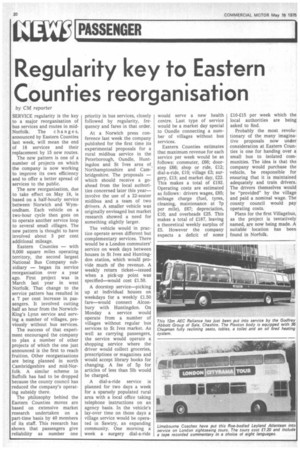Regularity key to Eastern Counties reorganisation
Page 22

If you've noticed an error in this article please click here to report it so we can fix it.
by CM reporter SERVICE regularity is the key to a major reorganisation of bus services and routes in mid Norfolk. The change s, announced by Eastern Counties last week, will mean the end of 18 services and their replacement by 15 new routes.
The new pattern is one of a number of projects on which the company is now working to improve its own efficiency and to offer a better spread of services to the public.
The new reorganisation, due to take effect on May 18, is based on a half-hourly service between Norwich and Wymondham. Each vehicle on a two-hour cycle then goes on to operate another service loop to several small villages. The new pattern is thought to have involved about 3 per cent additional mileage.
Eastern Counties — with 9,000 square miles operating territory, the second largest National Bus Company subsidiary — began its service reorganisation over a year ago. First project was in March last year in west Norfolk. That change to the service pattern has resulted in a 7 per cent increase in passengers. It involved cutting half an hour from the NorwichKing's Lynn service and serving a number of villages, previously without bus services.
The success of that experiment encouraged the company to plan a number of other projects of which the one just announced is the first to reach fruition. Other reorganisations are being planned in north Cambridgeshire and mid-Norfolk. A similar scheme in Suffolk has had to be dropped because the county council has reduced the company's operating subsidy there.
The philosophy behind the Eastern Counties moves are based on extensive market research undertaken on a part-time basis by 40 members of its staff. This research has shown that passengers give reliability as number one priority in bus services, closely followed by regularity, frequency and fares in that order.
At a Norwich press conference last week the company published for the first time its experimental proposals for a rural midibus service in the Peterborough, Oundle, Huntingdon and St Ives area of Northamptonshire and Cambridgeshire. The proposals — which should receive a goahead from the local authorities concerned later this year— involve the use of a 22-seater midibus and a team of two drivers. A smaller vehicle was originally envisaged but market research showed a need for something slightly larger.
The vehicle would in practice operate seven different but complementary services. There would be a London commuters' service on week days between houses in St Ives and Huntingdon station, which would provide much of the revenue. A weekly return ticket—issued when a pick-up point was specified—would cost £1.50.
A doorstep service—picking up at individual houses on weekdays for a weekly £1.50 fare—would connect Alconbury with Huntingdon. On Monday a service would operate from a number of villages without regular bus services to St Ives market. As well as carrying passengers, the service would operate a shopping service where the driver would collect groceries, prescriptions or magazines and would accept library books for changing. A fee of 5p for articles of less than 51b would be charged.
A dial-a-ride service is planned for two days a week for a sparsely populated rural area with a local office taking telephone instructions on an agency basis. In the vehicle's lay-over time on those days a village service would be operated in Sawtry, an expanding community. One morning a week a surgery dial-a-ride would serve a new health centre. Last type of service would be a market day special to Oundle connecting a number of villages without bus services.
Eastern Counties estimates that maximum revenue for each service per week would be as follows: commuter, £66; doorstep £66; shop or ride, £12; dial-a-ride, £10; village £3; surgery, £13; and market day, e22. This makes a total of £192. Operating costs are estimated as follows : drivers wages, £85; mileage charge (fuel, tyres, cleaning, maintenance at 7p per mile), £67; depreciation, £10; and overheads £25. This makes a total of £187, leaving a theoretical weekly surplus of £5. However the company expects a deficit of some £10-£15 per week which the local authorities are being asked to find.
Probably the most revolutionary of the many imaginative proposals now under consideration at Eastern Counties is one for handing over a small bus to isolated communities. The idea is that the company would purchase the vehicle, be responsible for ensuring that it •is maintained adequately and train drivers. The drivers themselves would be "provided" by the village and paid a nominal wage. The county council would pay operating costs.
Plans for the first Villagebus, as the project is tentatively named, are now being made. A suitable location has been found in Norfolk.




























































































